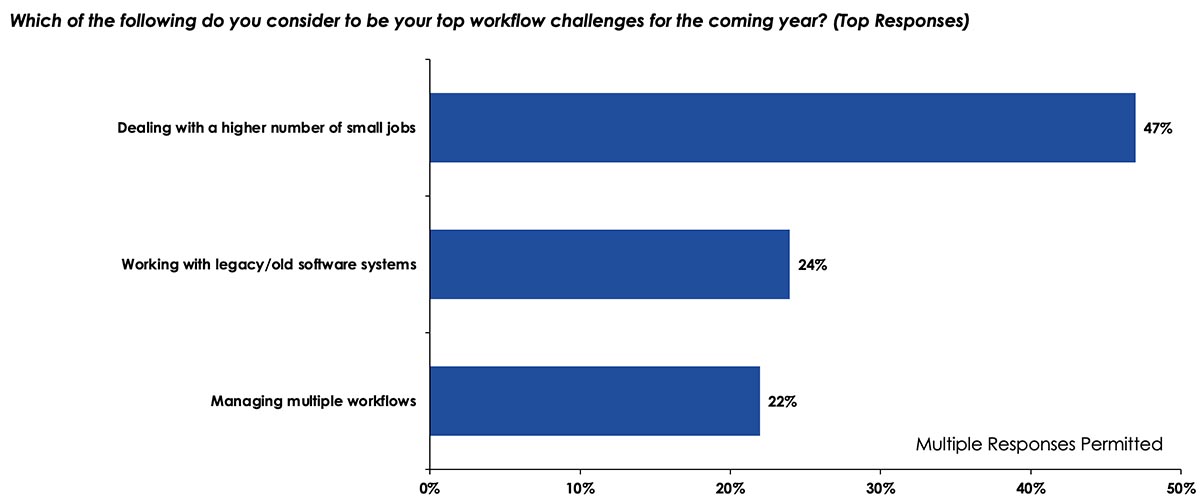- Using the same processes as your mix transitions from longer runs to short-run jobs can cause production chaos, as well as unanticipated financial effects.
- Nearly half of the PSP respondents to Keypoint Intelligence’s most recent Software Investment Outlook survey were having difficulty dealing with a high number of smaller jobs.
- Tilia Labs offers a range of planning and smart imposition solutions that enable businesses of all sizes to make the best use of their equipment and substrates while minimizing labor costs.
By Greg Cholmondeley
Introduction
Although change in the printing industry happens rapidly at times, other trends seemingly take years to mature. Over the past several years, many print service providers (PSPs) have found that they now need to manage, produce, and maintain a higher number of smaller jobs.
Ongoing technological improvements across all types of equipment have enabled today’s PSPs to produce work faster and more cost-effectively than ever before. In addition, the transition to on-demand printing meant that customers could order fewer quantities at a greater frequency. Brands and businesses have also increased customization and personalization so they can deliver more targeted and relevant communications to their customers.
Are Small Jobs Slowing You Down?
The net result of all these aforementioned factors is that small print jobs have been on the rise, even as many of the pre-production processes have remained unchanged. Smaller jobs need better, more automated processes to minimize production costs due to the lower price points and (in many cases) profit margins. Using the same processes as the mix transitions from longer runs to short-run jobs can cause production chaos, as well as unanticipated financial effects.
As businesses strive to deliver more accurate and targeted communications to their customers and prospects, the need for short-run production increases. It should come as no surprise that nearly half of the PSP respondents to Keypoint Intelligence’s most recent Software Investment Outlook survey were having difficulty dealing with a high number of smaller jobs.
Top Workflow Challenges for PSPs

N = 105 Print Service Provider Respondents
Source: NA Software Investment Outlook; Keypoint Intelligence 2021
The Need for Planning and Job Optimization
So what’s the best strategy for dealing with the increase in smaller jobs? The answer is better planning and job optimization. Adequate planning ensures that all print work is effectively using all available resources to maximize productivity and minimize costs. It will:
- Maximize the use of equipment by combining jobs with similar press run characteristics like paper and inks.
- Optimize the consumption of materials by calculating the best equipment, based on format size and running costs, for the least amount of waste per sheet and over the entire press run.
- Save labor costs by eliminating the time required to build and plan the best production scenario manually.
The traditional method of planning and imposing artwork for the printer has become labor-intensive, and it also relies heavily on staff expertise and knowledge. It is possible to spend hours creating a production plan based on the known mix of work and job criteria, only for plans to be disrupted as jobs are added or changed. There can also be additional interruptions from unavailable equipment due to capacity issues or required maintenance/repair.
Tilia Labs: Maximum Velocity with Intelligent Printing
Tilia Labs offers a range of planning and smart imposition solutions that enable businesses of all sizes to make the best use of their equipment and substrates while minimizing labor costs. Regardless of whether you offer commercial, label, folding carton, or wide-format printing services, Tilia Labs’ Imposition AI makes sense of the mix of jobs, considers all available printing methods, and calculates thousands of potential production layouts in seconds instead of hours. Businesses can select the best plan for them based on their costs, waste, service-level agreements (SLAs), and overall production schedule.
The Bottom Line
PSPs can better manage the influx of smaller jobs and optimize production by using intelligent planning software. Intelligent planning and imposition are critical for getting out of the small job slowdown and reaching maximum velocity in your printing operations, and planning and imposition tools like those from Tilia Labs can help get you there!
Greg Cholmondeley is a recognized expert on workflow automation, strategic planning, software solutions, and the printing industry. Before joining Keypoint Intelligence, he was President of PRINTelligence Consulting, where he analyzed and assessed production enhancement software solutions for vendor development and consumer understanding. He is a frequent speaker and panelist at industry events as well as a published author.














